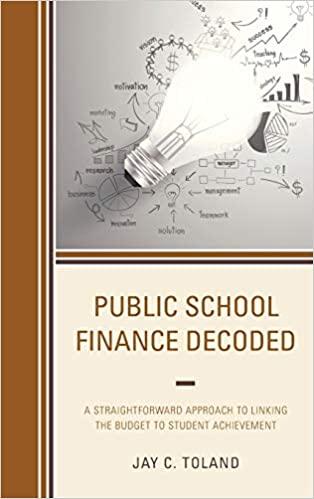Question
Consider an entrepreneur with no wealth but a great idea. An entrepreneur wants to raise the $50 million needed to start a business . The
- Consider an entrepreneur with no wealth but a great idea.
- An entrepreneur wants to raise the $50 million needed to start a business.
- The entrepreneur is rational, maximizes expected utility of wealth and is risk neutral.
- There is a 50 percent chance that the business will go well and make money, in which case the business will generate $100 million (for a profit of $50 million); there is a 50 percent chance that the business will go badly and lose money, in which case it will generate only $20 million (for a loss of $30 million).
- The entrepreneur has no wealth of his own, but wants to raise the needed $50 million total, from 10 loans of $5 million each from separate banks bank loans. There is a competitive market for loans from many competing banks who face no transaction costs.
- Each bank will give the entrepreneur $5 million. The entrepreneur promises to pay each bank fixed dollar amount out of the proceeds from the business if there is enough money to repay the loan, in which case the firm avoids bankruptcy.
- Each bank would be willing to accept an expected return of zero, so that they would be willing to put in $1 million for the promise of getting $1 million back on average. There are no taxes.
- If there is not enough money to pay any bank what they are owed, the firm will go into bankruptcy. In this case, the banks are jointly entitled to all firm assets; banks fight among themselves to be paid as much of what they are owed as possible. In the event of bankruptcy, legal fees incurred by the banks will total $10 million ($1 million per bank).
- Bankruptcy
- What amount must the entrepreneur promise to repay the bank (except in bankruptcy, when the banks will get whatever remains after legal fees) to make them willing to lend? What is the stated interest rate on the loan?
- Please fill in the table below with the amounts that will be received by each party if the project goes well, if it goes badly, and on average:
|
| Project goes well | Project goes badly | Expected outcome |
| Banks | |||
| Entrepreneur | |||
| Lawyers | |||
| Total |
2. Insurance. Now imagine that the problem setup is otherwise identical to what is described on the previous page, except that the entrepreneur is able to buy full insurance coverage. This insurance would pay the company $80 million in the event of the bad outcome (the difference between the amounts generated in the good and bad outcomes). Also, imagine that the entrepreneur can precommit to buy this insurance before raising money for the project. The choice is between no insurance and full insurance; no partial insurance options are available.
- What is the maximum amount the entrepreneur would be willing to pay for full insurance (if able to precommit to buy this insurance before raising money for the project)?
- Please fill in the table below with the amounts that will be received by each party if the project goes well, if it goes badly, and on average, if the entrepreneur bought the full insurance at the maximum price from (b.i):
|
| Project goes well | Project goes badly | Expected outcome |
| Banks | |||
| Entrepreneur | |||
| Lawyers | |||
| Total |
Step by Step Solution
There are 3 Steps involved in it
Step: 1

Get Instant Access to Expert-Tailored Solutions
See step-by-step solutions with expert insights and AI powered tools for academic success
Step: 2

Step: 3

Ace Your Homework with AI
Get the answers you need in no time with our AI-driven, step-by-step assistance
Get Started


